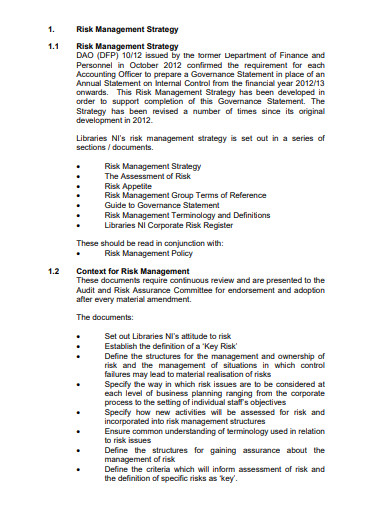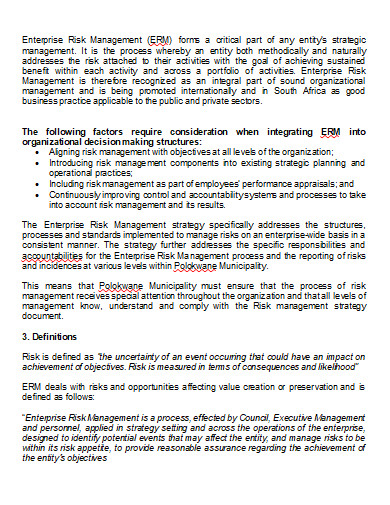10+ Risk Management Strategy Examples to Download
Risk management empowers businesses that helps them identify and prevent the potential risks. When you are able to identify a risk, it would be easier to handle and mitigate it. It also aids in providing you an opportunity to show good decision making in the field. Every business has to assess and manage risks. This prepares for any type of occurrences that might possibly come in the way. A business will make itself a successful entity when it has the ability to evaluate plans and handle threats in the best way it can. This will lead to ensuring that a business would still be profitable and has the necessary information.
10+ Risk Management Strategy Examples
1. Risk Management Strategy Template
2. Risk Management Strategy and Policy
3. Sample Risk Management Strategy
4. Risk Management Strategy Example
5. Formal Risk Management Strategy
6. Risk Management Strategy in PDF
7. Developing Risk Management Strategy
8. Flood Risk Management Strategy
9. Printable Risk Management Strategy
10. Student Protection Risk Management Strategy
11. Risk Management Strategy in DOC
Risk Management Strategy Definition
Risk management strategies present a detailed and structured approach in identifying potential risk. It does not only identify, but it also gives an assessment and correct management procedure. It is designed to build for reviewing the assessments which are based on developments. It can be developed either by small groups and large companies. An effective risk management would control outcomes proactively. It has the potential to reduce risks and its impact to the organization.
Effective Risk Management Strategies
1. Plan
Every business should consider having a plan. Even though the format varies, some would still end up having multiple pages while others only have a few. There could be items that one must consider in developing a risk management plan. First is to prepare a list of the risks. It is followed by the rating of each risk based on its impact. Next is the assessment and last is the plan of action. In order to know how effective your plan of action will be, you might consider using a five point scale: very inadequate, inadequate, satisfactory, strong, very strong.
2. Think about how to handle the risks
As soon as you have identified the risks, arrange them according to their impact. Decide what you are going to do with those risks using the four strategies: avoid, reduce, transfer and accept. Each of these strategies have their own advantages and disadvantages. Sometimes, it is easier to avoid the risk, to reduce, to transfer or to just accept it.
Avoiding the risk could be the one of the most effective way. You may just stop the activity that causes it. However, you may be losing some benefits. Reducing the risk means minimizing the impact when the risk occurs. Transferring the risk means insuring your properties to take out the liability insurance for protection. Accepting the risk means no cost and brings to focus more on the serious risks.
3. Monitor
Check whether your strategies are working and monitor them regularly. You have to spend a lot of time and effort preparing for this just to make sure to keep this management plan a living document. Every situation evolves through time and comes with a new set of risks. With that, it would be advisable to take a time going through with the plan.
FAQs
What could be some of the benefits in risk management?
It helps in creating a safe environment for the workers, protects the people from harm and defines your insurance needs.
Why are risk management important?
It is important because it helps in establishing methods on how to identify, analyze and evaluate potential risks that may threaten the overall condition of your organization.
What could be the three types of risk?
The three types of risks can be a business risk, non-business risk, and a financial risk.
If you got all the key points to remember in making a risk management plan, then it would be easier for you to protect your business against any types of pitfalls. The risk management strategy gives you an avenue to rank the risks presented according to how likely they are to occur and leave an impact into the industry. You just have to remember that all the details you have written must be written and presented clearly and objectively.













